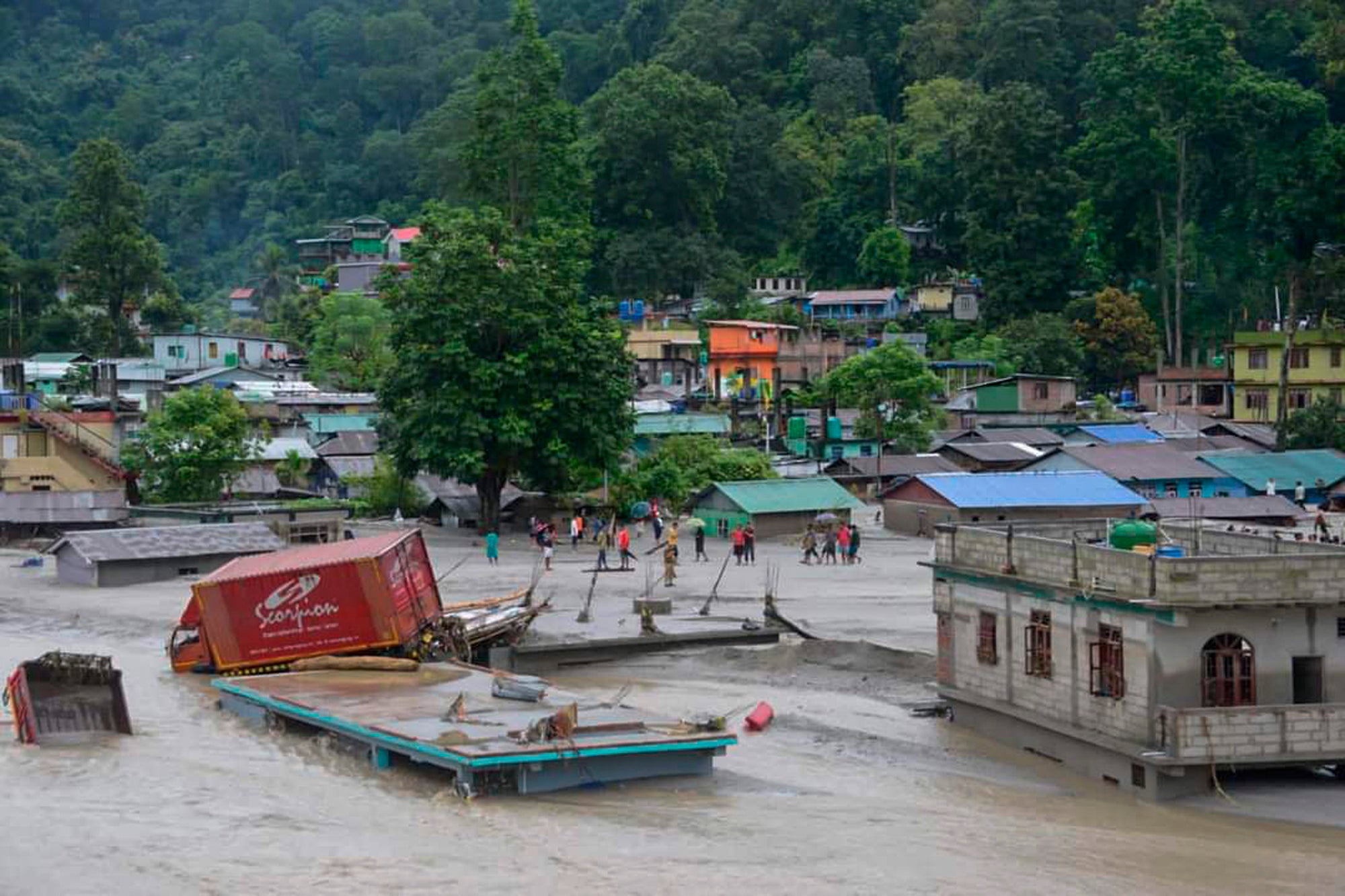Death toll rises to 14 after India cloudburst as just one missing soldier found
Extent of damage is such that parts of a dam were swept away – draining a lake of two-thirds of its water

At least 14 people were killed and 102 are missing in northeastern India after flash floods triggered by sudden heavy rainfall swamped several towns and washed away parts of a dam.
Lhonak lake in Sikkim state burst its banks on Wednesday and caused serious flooding, which authorities said has impacted 22,000 people and has become the latest deadly weather event in a mountainous region in south Asia that is being blamed on the climate crisis.
Among the missing are 22 soldiers, and the Indian army is carrying out extensive search and rescue operations to trace them. Some army camps and vehicles were submerged under mud following the floods. The army has managed to rescue only one soldier out of the 23 troops who had earlier been reported missing.
The extent of the damage to infrastructure is such that parts of a key dam linked to the state’s biggest hydro power project, apart from parts of a highway that joins Gangtok – the state capital – with the rest of the country were both washed away. The serious nature of the damage has impacted the hydro power project and the cost of rebuilding key infrastructure will run into millions of rupees, said officials.
Eleven bridges were swept away by floodwaters as well. The floods struck pipelines and damaged or destroyed more than 270 houses in four districts as well.
The weather department said Sikkim received 101mm (4 inches) of rain in the first five days of October, more than double the normal levels, triggering floods worse than the one in October 1968 in which an estimated 1,000 people were killed.
The department has predicted heavy rain over the next three days in parts of Sikkim and neighbouring states.
Photos of the Lhonak lake before and after the floods have revealed the extent of the damage. The satellite imagery showed nearly two-thirds of the lake seem to have been drained.
The flooding occurred along the Teesta river in Sikkim’s Lachen valley and worsened after parts of the dam linked to the power project – called Sikkim Urja (energy in Hindi) – were washed away.
“The dam and the bridge have to be rebuilt and the rebuilding cost would run in thousands of crores rupees. The losses would be thousands of crores,” Sunil Saraogi, the executive chairman of Sikkim Urja Limited, told the Hindustan Times.
The condition of the dams in the state have once again come into question in the aftermath of the floods.
A Right to Information request filed in 2013 found that “out of the 12 dams in Sikkim, seven are in a vulnerable condition”, environmental activist Mukut Biswas told The Wire news portal.
Environmental activists have been raising concerns about large-scale infrastructure projects in the Eastern Himalayas, including the building of dams, as the region is known to be highly susceptible to earthquakes.
A 2020 report by India’s National Disaster Management Agency said glacial lakes are growing and pose a potentially large risk to downstream infrastructure and life. This is because glaciers in the Himalayas are melting due to the climate crisis.
“Sadly, this is the latest in a series of deadly flash floods that ricocheted across the Hindu Kush-Himalayan region this monsoon, bringing the reality of this region’s extreme vulnerability to climate change all too vividly alive,” said Pema Gyamtsho, director-general of the Nepal-based International Centre for Integrated Mountain Development.
Several towns, including Dikchu and Rangpo in the Teesta basin, were flooded and schools in four districts were ordered to be shut until Sunday, the state’s education department said.
Four of the dam’s gates were washed away and it was not clear why they had not been opened in time, a government source told Reuters.
Prime minister Narendra Modi’s office said in a statement that the government would support state authorities in the aftermath of the flooding.
“Continued efforts are on to dig out vehicles submerged under the slush at Burdang near Singtam. The search for the missing persons is now focusing in the areas downstream of Teesta river,” an Indian defence spokesperson said.
Authorities in neighbouring Bangladesh are on alert. A state-run water development board official warned five districts in the northern part of the country could be inundated with a rise in the level of the Teesta, which enters Bangladesh downstream of Sikkim.
The flooding was caused by cloudbursts – sudden, very heavy rains – defined as such when more than 10cm of rainfall occurs within 10 sq km within an hour.
Video footage from the ANI news agency showed floodwaters surging into built-up areas where several houses collapsed. Army bases and other facilities were damaged and vehicles submerged.
Sikkim, a small state of about 650,000 people wedged in the mountains between Nepal, Bhutan and China, was cut off from Siliguri in neighbouring West Bengal state as the main highway had collapsed.
State lawmaker GT Dhungel said petrol and diesel had become scarce in Gangtok, but food was readily available.
Additional reporting by agencies
Subscribe to Independent Premium to bookmark this article
Want to bookmark your favourite articles and stories to read or reference later? Start your Independent Premium subscription today.

Join our commenting forum
Join thought-provoking conversations, follow other Independent readers and see their replies